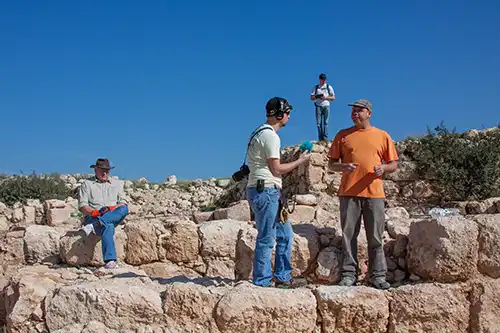Timeline

Timeline
Though the soil of the valleys and the lower areas contain a high sand content, the region features large tracts of fertile land. The region is characterized by its hills of marl-covered soft limestone, distinctly different from the hard limestone and dolomite that form the Judean Hills.
During the Hellenistic period, Jews of the Land of Israel were concentrated in Judea, with Jerusalem as their spiritual and administrative center. Other ethnic groups, such as pagan Idumeans, occupied the Judean Lowland where Beit Lehi is located, and the Arad and Beer Sheva valleys in the south.
The largest Idumean cities were Maresha, located some four miles northwest of Beit Lehi, and Adoraim, situated in the Hebron Hills to the east. This situation changed following the Hasmonean conquests of the late second century BC, as Jewish rule also expanded southward into Idumea. The Hasmoneans, known also as the Maccabees, were the rulers of an independent Jewish kingdom that controlled vast swathes of what is today modern Israel between 167-37 BC. According to the Jewish Roman-period historian, Josephus Flavius, Maresha was conquered by the Hasmonean ruler John Hyrcanus I in 112/113 BC and its inhabitants forcibly converted to Judaism (Antiquities XIII, 257-258).

The site was first surveyed in 1899 by the Irish archaeologist R.A.S. Macalister, but was left untouched until 1961 when the Israeli Army, carrying out construction works on a patrol road, that at the time marked the border between Israel and Jordan, accidentally broke through the ceiling of an ancient burial cave. Subsequent investigation revealed a total of two such caves, both dating to the late Iron Age II (ca. 600 BC) – but the landmark discovery was to be the inscription found incised on one of the walls, comprising the earliest known Hebrew inscription mentioning the word “Jerusalem.” This discovery has come to be known as the “Jerusalem Cave,” and the original scholarly article about the findings, written by the late Prof. J. Naveh and published in a 1963 issue of the Israel Exploration Journal.
Following these discoveries, new interest was taken in the site of Beit Lehi, but further excavations would not take place until the early 1980s. Between 1979 and 1983 the caves at the site were surveyed by Y. Tepper and Y. Shahar on behalf of the Israel Department of Antiquities (today’s Israel Antiques Department; henceforth – IAA). Work continued and between 1982 and 1986 Y. Dagan, also of the IAA, conducted a large survey in the area. This survey not only yielded pottery and flint tools from the Chalcolithic and the Early Bronze II-III periods (fifth to third millennia BC), pottery and burial caves from the Iron Age (seventh and sixth centuries BC), but also established that the site had been settled from the Hellenistic to the Mamluk period (third century BC to fourteenth century AD).
In 1983 and 1986 two excavations were conducted by the late Prof. Y. Tsafrir and J. Patrich of the Hebrew University of Jerusalem, with the assistance of C. Skousen and G. Kimber of Salt Lake City, Utah. At this time, the basilica church with its impressive mosaic floor and the adjacent oil press were discovered, as well as a rock-hewn winepress and burial cave, all dating from the Byzantine and Early Islamic periods.
After these initial excavations, the project once again came to a stop until 2005, at which time Dr. Oren Gutfeld (then a doctoral candidate) was introduced to the site by Prof. Tsafrir, his dissertation advisor. Prof. Tsafrir himself had become aware of the site through his close friend, the late Prof. J. Ginat of Netanya Academic College, who had been active for over thirty years in promoting the site. Not surprisingly, Oren Gutfeld was immediately intrigued, and in October of that year he and his team carried out what would become the first season of the renewed Beit Lehi excavation project, also under the auspices of the Hebrew University of Jerusalem. Over the next decade they would average two seasons per year.
Since excavations resumed in 2005, numerous subterranean columbaria (dovecotes), five oil presses, two Jewish ritual baths, two stables, several quarries, and numerous water cisterns and subterranean tunnels have also been exposed.
The ruins of a medieval village have been found at the center of the site, superimposed upon earlier remains dating from the Byzantine, Early Roman, and Hellenistic periods.
Starting in 2008, the excavations and the site development have been sponsored by the Beit Lehi Foundation. The work force at the site comprises mostly volunteers from the United States including students from Kimber Academy, Utah Valley University, and universities in Israel.
